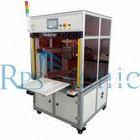
loading
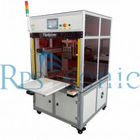

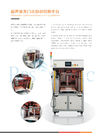

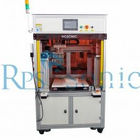



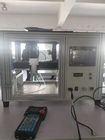

| Quantity: | |
| Place of Origin | China |
|---|---|
| Brand Name | Rps-sonic |
| Certification | CE |
| Model Number | RPS-C20 |
| Minimum Order Quantity | 1pcs |
| Price | negotiable |
| Packaging Details | CARTON |
| Delivery Time | 1DAYS |
| Payment Terms | T/T |
| Supply Ability | 200PCS/MONTH |
| Frequency | 20Khz | Power | 6000w In Max |
|---|---|---|---|
| Blade Size | 305mm | Height | 80mm |
| Blade Material | Titanium | Voltage | 220/110V |
| Weight | 120kg |
20khz Automated Ultrasonic Cake Cutting Machine easy to apply to automated production
What's the principle of ultrasonic cutting?
The principle of an ultrasonic cutter is completely different from conventional one. It uses the energy of ultrasonic to melt the material to be cut. Therefore, the ultrasonic cutting does not require a sharp cutting edge, nor does it require a large pressure, and does not cause any chipping or breakage. At the same time, since the cutting blade is subjected to ultrasonic vibration, the frictional resistance is particularly small, and the material to be cut is not easily adhered to the blade. This is particularly effective for cutting viscous and elastic materials, frozen materials such as food, rubber, etc., or objects that are inconvenient to apply pressure.
The basic structure of the ultrasonic cutting machine is an ultrasonic transducer, a horn, a cutting blade (tool head), and generator. The ultrasonic generator converts the commercial power into a high-frequency high-voltage alternating current and transmits it to the ultrasonic transducer. An ultrasonic transducer is actually equivalent to an energy conversion device that converts input electrical energy into mechanical energy, ie, ultrasonic waves. Its manifestation is that the transducer moves back and forth in the longitudinal direction. The frequency of the telescopic motion is equivalent to the frequency of the high frequency alternating current supplied by the driving power source. The role of the horn is to fix the entire ultrasonic vibration system and to amplify the output amplitude of the transducer. The cutting blade (tool head) further enlarges the amplitude on the one hand and focuses the ultrasonic wave. On the other hand, the ultrasonic wave is output, and the ultrasonic energy is concentratedly input to the cutting portion of the material to be cut by using a similar cutting edge of the cutting blade. Under the action of huge ultrasonic energy, this part softens and melts instantly, and the strength is greatly reduced. At this time, as long as a small cutting force is applied, the purpose of cutting the material can be achieved.
Similar to conventional cutting, the basic components required are a cutter and an anvil, and the ultrasonic cutter has two basic structures. Depending on the location of the ultrasonic application, we may wish to divide it into an ultrasonic cutter cutter and an ultrasonic cutter cutter.
The ultrasonic cutter cutter directly loads the ultrasonic energy onto the cutter, and the cutter becomes a cutter with ultrasonic waves. When cutting the material, the material is mainly softened and melted by the ultrasonic energy, and the cutting edge of the cutter only serves as the slit positioning, the ultrasonic energy output, and the separation material. This cutting method is suitable for cutting thick, thick, long, etc. materials that are inconvenient to set the cutting board. Such as raw rubber output from the rubber mixer, pipe cutting, frozen meat, candy, chocolate cutting, printed circuit boards, or hand-held cutting machines.
The basic structure of the ultrasonic cutting board cutter is similar to that of the ultrasonic cutter cutter, except that the ultrasonic output portion is not a cutter but a standard ultrasonic flat mold. Here, the mold is equivalent to a cutting board. However, this is a cutting board that is used for ultrasonic vibration. The cutting knife can still be used in the traditional shape, but the sharpness of the cutting edge is reduced, and the life of the cutting knife is greatly extended.
Paramater
| Item | paramter |
| Dimension | 2400*1200*1800mm |
| Weight | 600kgs |
| Power | 6Kw in max, depending on the cutter numbers |
| speed | 60times/min in max |
| Cutting knifes | 3 pcs in max |
| Frame material | 304 stainless steel |
| function | food cutting/ rubber cutting |

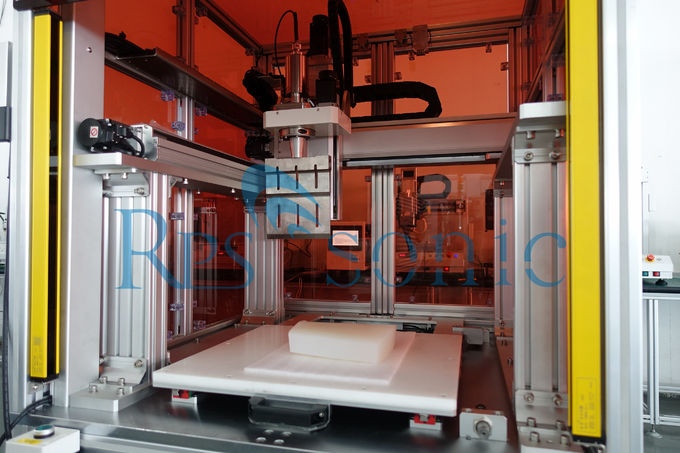
| Frequency | 20Khz | Power | 6000w In Max |
|---|---|---|---|
| Blade Size | 305mm | Height | 80mm |
| Blade Material | Titanium | Voltage | 220/110V |
| Weight | 120kg |
20khz Automated Ultrasonic Cake Cutting Machine easy to apply to automated production
What's the principle of ultrasonic cutting?
The principle of an ultrasonic cutter is completely different from conventional one. It uses the energy of ultrasonic to melt the material to be cut. Therefore, the ultrasonic cutting does not require a sharp cutting edge, nor does it require a large pressure, and does not cause any chipping or breakage. At the same time, since the cutting blade is subjected to ultrasonic vibration, the frictional resistance is particularly small, and the material to be cut is not easily adhered to the blade. This is particularly effective for cutting viscous and elastic materials, frozen materials such as food, rubber, etc., or objects that are inconvenient to apply pressure.
The basic structure of the ultrasonic cutting machine is an ultrasonic transducer, a horn, a cutting blade (tool head), and generator. The ultrasonic generator converts the commercial power into a high-frequency high-voltage alternating current and transmits it to the ultrasonic transducer. An ultrasonic transducer is actually equivalent to an energy conversion device that converts input electrical energy into mechanical energy, ie, ultrasonic waves. Its manifestation is that the transducer moves back and forth in the longitudinal direction. The frequency of the telescopic motion is equivalent to the frequency of the high frequency alternating current supplied by the driving power source. The role of the horn is to fix the entire ultrasonic vibration system and to amplify the output amplitude of the transducer. The cutting blade (tool head) further enlarges the amplitude on the one hand and focuses the ultrasonic wave. On the other hand, the ultrasonic wave is output, and the ultrasonic energy is concentratedly input to the cutting portion of the material to be cut by using a similar cutting edge of the cutting blade. Under the action of huge ultrasonic energy, this part softens and melts instantly, and the strength is greatly reduced. At this time, as long as a small cutting force is applied, the purpose of cutting the material can be achieved.
Similar to conventional cutting, the basic components required are a cutter and an anvil, and the ultrasonic cutter has two basic structures. Depending on the location of the ultrasonic application, we may wish to divide it into an ultrasonic cutter cutter and an ultrasonic cutter cutter.
The ultrasonic cutter cutter directly loads the ultrasonic energy onto the cutter, and the cutter becomes a cutter with ultrasonic waves. When cutting the material, the material is mainly softened and melted by the ultrasonic energy, and the cutting edge of the cutter only serves as the slit positioning, the ultrasonic energy output, and the separation material. This cutting method is suitable for cutting thick, thick, long, etc. materials that are inconvenient to set the cutting board. Such as raw rubber output from the rubber mixer, pipe cutting, frozen meat, candy, chocolate cutting, printed circuit boards, or hand-held cutting machines.
The basic structure of the ultrasonic cutting board cutter is similar to that of the ultrasonic cutter cutter, except that the ultrasonic output portion is not a cutter but a standard ultrasonic flat mold. Here, the mold is equivalent to a cutting board. However, this is a cutting board that is used for ultrasonic vibration. The cutting knife can still be used in the traditional shape, but the sharpness of the cutting edge is reduced, and the life of the cutting knife is greatly extended.
Paramater
| Item | paramter |
| Dimension | 2400*1200*1800mm |
| Weight | 600kgs |
| Power | 6Kw in max, depending on the cutter numbers |
| speed | 60times/min in max |
| Cutting knifes | 3 pcs in max |
| Frame material | 304 stainless steel |
| function | food cutting/ rubber cutting |










Ultrasonic Welding Equipment Ultrasonic Welding Transducer Ultrasonic Welding Converter Ultrasonic Liquid Processor Ultrasonic Cutting Equipment Ultrasonic Spray Nozzles Ultrasonic Power Supply Ultrasonic Soldering Equipment Ultrasonic Welding Horn Ultrasonic Assisted Machining Ultrasonic Testing Equipment
content is empty!